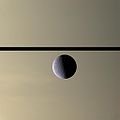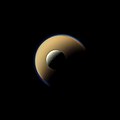Rhea (měsíc)
| Rhea | |
|---|---|
 Měsíc Rhea na fotografii pořízené sondou Cassini. Na fotografii je obrovský kráter Tirawa | |
| Identifikátory | |
| Typ | měsíc |
| Označení | Saturn V |
| Objeveno | |
| Datum | 23. prosince 1672 |
| Objevitel | Giovanni Domenico Cassini |
| Elementy dráhy (Ekvinokcium J2000,0) | |
| Velká poloosa | 527 108 km |
| Výstřednost | 0,001 2583 |
| Orbitální rychlost | |
| - průměrná | 8,48 km/s |
| Mateřská planeta | Saturn |
| Fyzikální charakteristiky | |
| Polární průměr | 763,5 ± 0,5[1] km |
| Povrch | 7 337 000 km² |
| Hmotnost | (2,3064854 ± 0,0000522)×1021 kg |
| Průměrná hustota | 1,2372 ± 0,0029 g/cm³ |
| Gravitace na rovníku | 0,264 m/s² |
| Úniková rychlost | 0.635 km/s |
| Albedo | 0,949 |
| Povrchová teplota | |
| - průměrná | 53-99 K |
Rhea je měsíc planety Saturn. Objevena byla roku 1672 italsko-francouzským astronomem Giovannim Domenicem Cassinim. Doba jednoho oběhu kolem planety je 4,517500436 dne a rotace je vázaná.[1] Teploty na povrchu se pohybují v rozmezí 53 až 99 K.
Prstenec
V roce 2008 vědci zjistili, že Rhea, jako snad jediný měsíc v sluneční soustavě, by měla mít kolem sebe trojitý prstenec z prachu.[2] Další pozorování však toto nepotvrdila.
Atmosféra
V roce 2010, po blízkém průletu sondy Cassini (necelých 100 km nad povrchem měsíce), se potvrdil předpoklad vědců: bylo zjištěno, že Rhea má slabou atmosféru tvořenou ze 70 % kyslíkem a ze 30 % oxidem uhličitým. Ve srovnání se Zemí je však kyslík v atmosféře Rhey zhruba 5biliónkrát řidší.[3]
Galerie
- Krátery na povrchu pořízené sondou Cassini z výšky 3788 km.
- Rhea před Saturnem
- Krátery na povrchu sondou Cassini (2012)
- Rhea a Titan na pozadí
Odkazy
Reference
- ↑ a b JACOBSON, Robert. A. The Orbits of the Main Saturnian Satellites, the Saturnian System Gravity Field, and the Orientation of Saturn's Pole. The Astronomical Journal. 1 November 2022, s. 199. DOI 10.3847/1538-3881/ac90c9. S2CID 252992162. Bibcode 2022AJ....164..199J.
- ↑ Článek Saturn's Moon Rhea Also May Have Rings na webu NASA. www.nasa.gov [online]. [cit. 2011-07-17]. Dostupné v archivu pořízeném z originálu dne 2012-10-22.
- ↑ Článek Rhea's Oxygen Atmosphere na webu Astrobiology Magazine. astrobio.net [online]. [cit. 2012-02-02]. Dostupné v archivu pořízeném z originálu dne 2012-07-26.
Externí odkazy
 Obrázky, zvuky či videa k tématu Rhea na Wikimedia Commons
Obrázky, zvuky či videa k tématu Rhea na Wikimedia Commons
Média použitá na této stránce
Diameter comparison of Saturn's moon Dione, the Moon and Earth
Scale approx. 29km per px.
original description: This giant mosaic reveals Saturn's icy moon Rhea in her full, crater-scarred glory. This view consists of 21 clear-filter images and is centered at 0.4 degrees south latitude, 171 degrees west longitude.
The Cassini spacecraft looks toward Rhea's cratered, icy landscape with the dark line of Saturn's ringplane and the planet's murky atmosphere as a background.
Rhea is Saturn's second-largest moon, at 1,528 kilometers (949 miles) across. This view looks toward the unilluminated side of the rings from less than a degree above the ringplane.
Images taken using red, green and blue spectral filters were combined to create this natural color view. The images were acquired with the Cassini spacecraft narrow-angle camera on July 17, 2007 at a distance of approximately 1.2 million kilometers (770,000 miles) from Rhea. Image scale is 7 kilometers (5 miles) per pixel.This image was taken on March 09, 2013, and received on Earth March 10, 2013, by NASA's Cassini spacecraft. The camera was pointing toward Rhea at approximately 2,348 miles (3,778 kilometers) away, and the image was taken using the CL1 and CL2 filters. This image has not been validated or calibrated
Bombarded Rhea
Cassini looks over the heavily cratered surface of Rhea during the spacecraft's flyby of the moon on March 10, 2012.
See PIA08909 and PIA06553 to learn more about the impacts that have shaped the surface of Rhea (949 miles, or 1,528 kilometers across). This view is centered on terrain at 58 degrees north latitude, 84 degrees west longitude on Rhea. . The image was taken in visible light with the Cassini spacecraft narrow-angle camera. The view was obtained at a distance of approximately 27,000 miles (43,000 kilometers) from Rhea and at a Sun-Rhea-spacecraft, or phase, angle of 67 degrees. Image scale is 827 feet (252 meters) per pixel.Description from NASA :
Saturn's largest and second largest moons, Titan and Rhea, appear to be stacked on top of each other in this true-color scene from NASA's Cassini spacecraft.
The north polar hood can be seen on Titan (3,200 miles or 5,150 kilometers across) appearing as a detached layer at the top of the moon on the top right. See PIA08137 to learn more about Titan's atmosphere and the north polar hood.
This view looks toward the Saturn-facing side of Rhea (949 miles or 1528 kilometers across). North on Rhea is up and rotated 35 degrees to the right.
Images taken using red, green and blue spectral filters were combined to create this natural-color view. The images were acquired with the Cassini spacecraft narrow-angle camera on June 16, 2011, at a distance of approximately 1.1 million miles (1.8 million kilometers) from Rhea and 1.5 million miles (2.5 million kilometers) from Titan. Image scale is 7 miles (11 kilometers) per pixel on Rhea and 9 miles (15 kilometers) on Titan.
The Cassini-Huygens mission is a cooperative project of NASA, the European Space Agency and the Italian Space Agency. The Jet Propulsion Laboratory, a division of the California Institute of Technology in Pasadena, manages the mission for NASA's Science Mission Directorate, Washington, D.C. The Cassini orbiter and its two onboard cameras were designed, developed and assembled at JPL. The imaging operations center is based at the Space Science Institute in Boulder, Colo.
For more information about the Cassini-Huygens mission visit http://saturn.jpl.nasa.gov and http://www.nasa.gov/cassini. The Cassini imaging team homepage is at http://ciclops.org.









